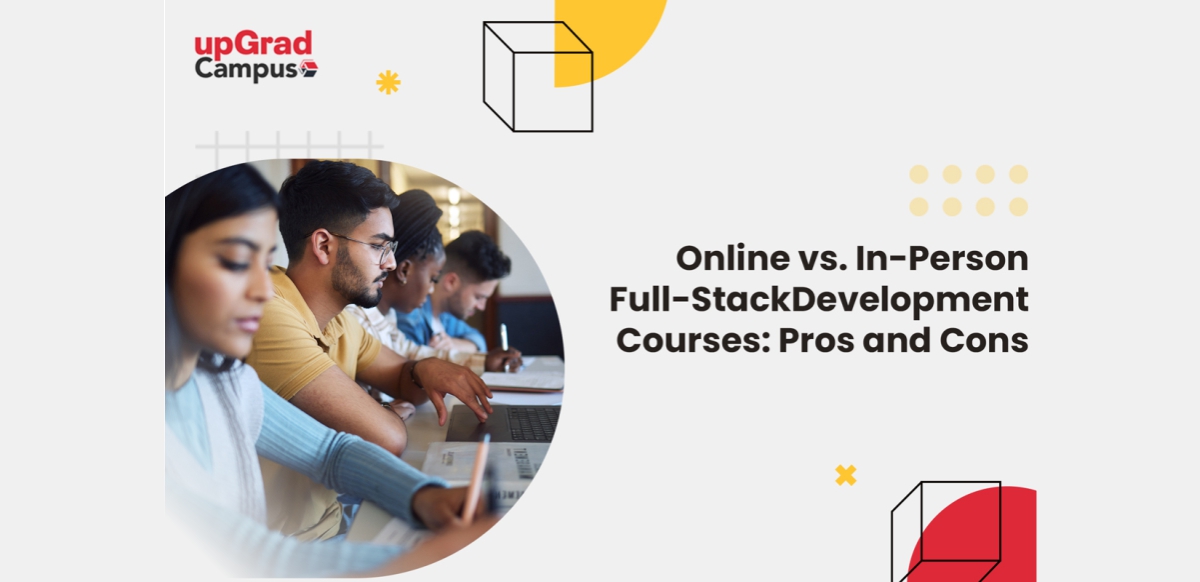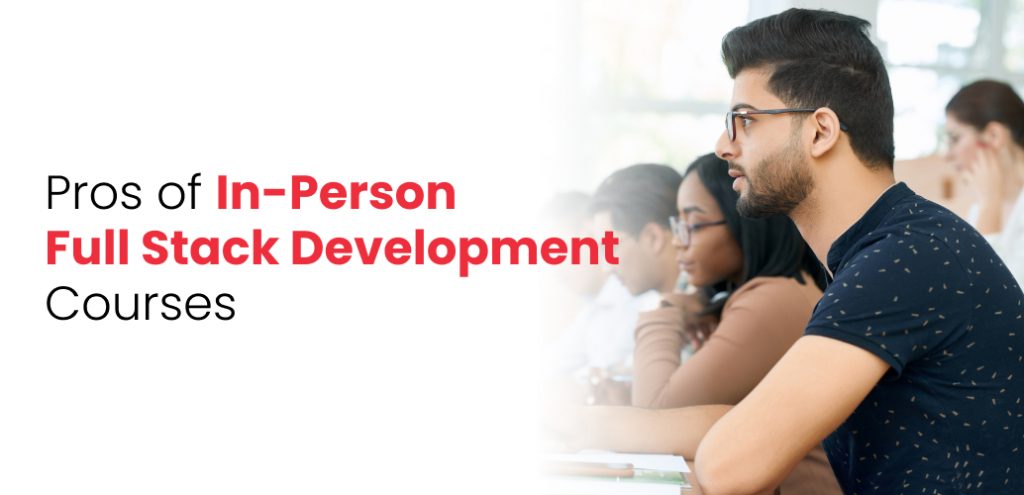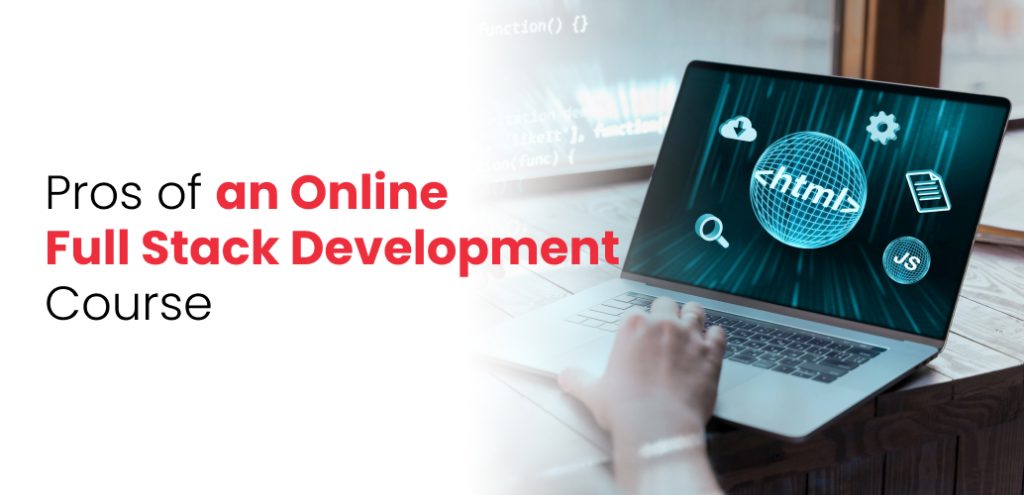Blog > Online vs. In-Person Full-Stack Development Courses: Pros and Cons
Online vs. In-Person Full-Stack Development Courses: Pros and Cons
October 4th, 2023

Table of Contents:
With the wealth of resources available today, aspiring developers can pursue their passion of undertaking a full-stack development course online or in person. These various educational avenues present students with the tools to acquire the necessary skills and knowledge they need to excel in their careers. Both online as well as in-person full-stack web development courses with certification have their own set of distinct advantages and drawbacks. The choice between these two boils down to each student’s unique learning method and their individual goals.
Also Read: How to Get Interview Ready for your Dream Job
In this blog, we’ll explore the pros and cons of completing a full-stack web developer course with certification online and in person so that students can make informed decisions based on their unique needs.
Let’s explore the pros of the full-stack Java developer course in person first.
Now let’s examine the pros of an online full-stack development course.
Further, group projects done with peers who stay in distant locations can be split into different meeting rooms on video-calling tools. This allows students from different backgrounds to collaborate, facilitating better peer learning.
If you wish to enroll in a full-stack web development course with certification, head over to upGrad Campus. With interactive online classes with LIVE doubt-clearing sessions, students get the best of both worlds. The program is led by professionals with years of industry experience, helping students learn and form lasting connections. Additionally, there are affordable EMI options making this full-stack development course even more pocket-friendly.
Reach out to any upGrad Campus Learning Consultants to understand more about our full-stack development course fees, scholarships, eligibility, and other important information. With upGrad Campus, start building your future today!
- Online vs. In-Person Full-Stack Development Courses: Pros and Cons
- Pros of In-Person Full Stack Development Courses
- 1. Face-to-Face Learning
- 2. Supervised Learning
- 3. Opportunities to Network
- 4. Access to Computers and Other Resources
- Cons of In-Person Full Stack Development Courses
- Pros of an Online Full Stack Development Course
- 1. Greater Flexibility
- 2. Convenience
- 3. Virtual Classes and Interactive Elements
- 4. Economically Beneficial
- Cons of Full Stack Development Courses Online
- Choosing the Right Path: Online vs. In-Person Full Stack Development Courses
With the wealth of resources available today, aspiring developers can pursue their passion of undertaking a full-stack development course online or in person. These various educational avenues present students with the tools to acquire the necessary skills and knowledge they need to excel in their careers. Both online as well as in-person full-stack web development courses with certification have their own set of distinct advantages and drawbacks. The choice between these two boils down to each student’s unique learning method and their individual goals.
Also Read: How to Get Interview Ready for your Dream Job
In this blog, we’ll explore the pros and cons of completing a full-stack web developer course with certification online and in person so that students can make informed decisions based on their unique needs.
Pros of In-Person Full Stack Development Courses

Let’s explore the pros of the full-stack Java developer course in person first.
1. Face-to-Face Learning
In-person courses generally tend to be for learners who prefer real-time engagement with the course instructors and their peers. This can facilitate a more interactive form of learning and help with quicker problem-solving of doubts.2. Supervised Learning
Another advantage of an in-person medium is that it offers more supervision and a stricter adherence to schedule, meaning students can stay more motivated and focused.3. Opportunities to Network
Full-stack development courses, which are conducted in a classroom or a campus environment, can provide unmatched networking opportunities for students. This enables them to meet industry titans and leading veterans. Students can maximise this opportunity by undertaking volunteer work or internships with potential employers as well.4. Access to Computers and Other Resources
Students who choose to enroll in a full-stack Java developer course in person get access to important resources such as computers, updated software, textbooks, and more. All of these could lead to an enriched learning experience. Moreover, students from weaker economic backgrounds who cannot afford these resources can also benefit from on-campus full-stack development courses.Cons of In-Person Full Stack Development Courses
While in-person full-stack development courses offer plenty of benefits, it’s important to recognise the drawbacks. Some of these are:- Limited seats available
- Less flexibility in terms of timing
- In-person full-stack development course fees tend to be slightly higher
- Students might have difficulty reaching the location
Pros of an Online Full Stack Development Course

Now let’s examine the pros of an online full-stack development course.
1. Greater Flexibility
The online nature of these courses means that students enjoy greater flexibility in terms of timings, travel, and the ability to revisit recorded lectures later.2. Convenience
Students enrolled in a full-stack developer course online enjoy greater convenience as they do not need to worry about commuting to a location far from their house. This saves them the hassle of dealing with traffic since they can learn from the comfort of their home.3. Virtual Classes and Interactive Elements
Full-stack development courses conducted in an online capacity typically feature lots of interactive elements, such as virtual classes, interactive videos, and online quizzes, which can be a fun and exciting way of learning.Further, group projects done with peers who stay in distant locations can be split into different meeting rooms on video-calling tools. This allows students from different backgrounds to collaborate, facilitating better peer learning.
4. Economically Beneficial
Online full-stack development courses often cost less compared to in-person alternatives. Students do not only save on their full-stack development course fees but also on external expenses such as commute and accommodation.Cons of Full Stack Development Courses Online
Let’s discover some cons of full-stack development courses conducted online:- Students miss out on face-to-face interactions, and it is typically harder to get doubts solved through an online medium.
- Need a fast and reliable internet connection at all times.
- Online courses also typically don’t allow for out-of-classroom interactions with instructors, making it harder to form a rapport with them.
- Students might have difficulty with technology and understanding other resources.
- Limited networking opportunities as compared to in-person classes.
Choosing the Right Path: Online vs. In-Person Full Stack Development Courses
Full-stack development is a field ripe for the future. With a plethora of prosperous career opportunities, those who master this technology today will be industry leaders tomorrow. But to be able to excel in a field as complicated and competitive as full-stack development, you need to learn from the best.If you wish to enroll in a full-stack web development course with certification, head over to upGrad Campus. With interactive online classes with LIVE doubt-clearing sessions, students get the best of both worlds. The program is led by professionals with years of industry experience, helping students learn and form lasting connections. Additionally, there are affordable EMI options making this full-stack development course even more pocket-friendly.
Reach out to any upGrad Campus Learning Consultants to understand more about our full-stack development course fees, scholarships, eligibility, and other important information. With upGrad Campus, start building your future today!






Add a Comment